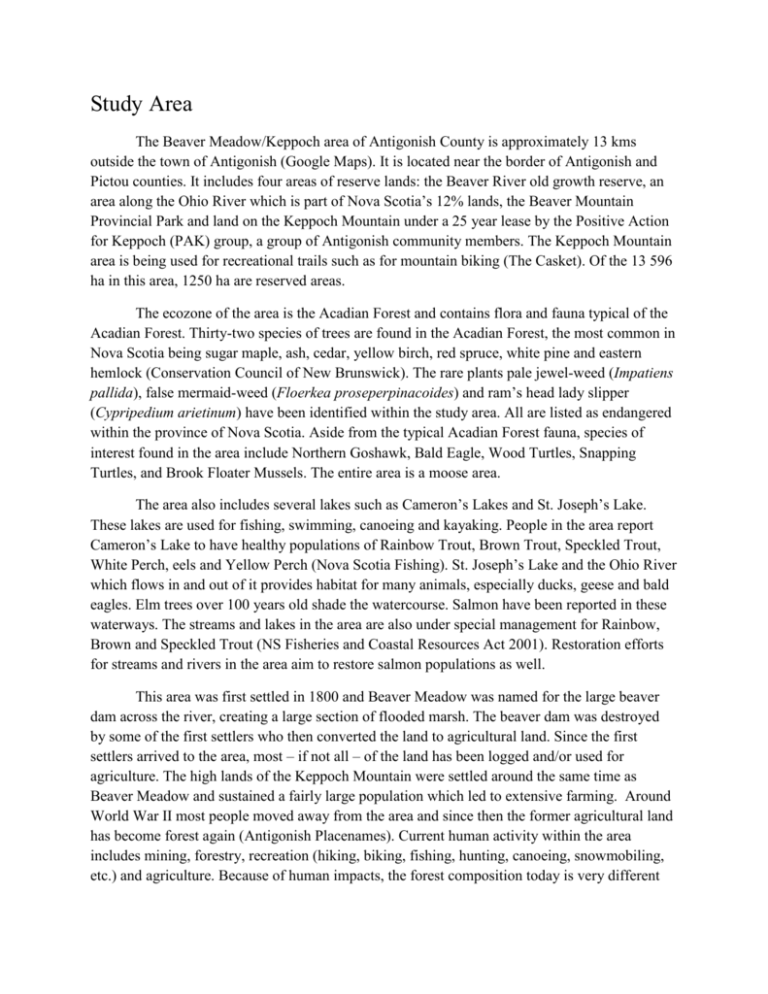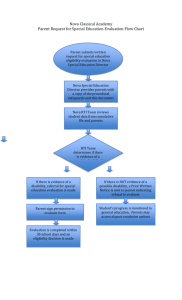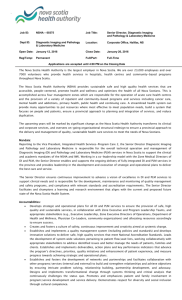Study Area 2
advertisement

Study Area The Beaver Meadow/Keppoch area of Antigonish County is approximately 13 kms outside the town of Antigonish (Google Maps). It is located near the border of Antigonish and Pictou counties. It includes four areas of reserve lands: the Beaver River old growth reserve, an area along the Ohio River which is part of Nova Scotia’s 12% lands, the Beaver Mountain Provincial Park and land on the Keppoch Mountain under a 25 year lease by the Positive Action for Keppoch (PAK) group, a group of Antigonish community members. The Keppoch Mountain area is being used for recreational trails such as for mountain biking (The Casket). Of the 13 596 ha in this area, 1250 ha are reserved areas. The ecozone of the area is the Acadian Forest and contains flora and fauna typical of the Acadian Forest. Thirty-two species of trees are found in the Acadian Forest, the most common in Nova Scotia being sugar maple, ash, cedar, yellow birch, red spruce, white pine and eastern hemlock (Conservation Council of New Brunswick). The rare plants pale jewel-weed (Impatiens pallida), false mermaid-weed (Floerkea proseperpinacoides) and ram’s head lady slipper (Cypripedium arietinum) have been identified within the study area. All are listed as endangered within the province of Nova Scotia. Aside from the typical Acadian Forest fauna, species of interest found in the area include Northern Goshawk, Bald Eagle, Wood Turtles, Snapping Turtles, and Brook Floater Mussels. The entire area is a moose area. The area also includes several lakes such as Cameron’s Lakes and St. Joseph’s Lake. These lakes are used for fishing, swimming, canoeing and kayaking. People in the area report Cameron’s Lake to have healthy populations of Rainbow Trout, Brown Trout, Speckled Trout, White Perch, eels and Yellow Perch (Nova Scotia Fishing). St. Joseph’s Lake and the Ohio River which flows in and out of it provides habitat for many animals, especially ducks, geese and bald eagles. Elm trees over 100 years old shade the watercourse. Salmon have been reported in these waterways. The streams and lakes in the area are also under special management for Rainbow, Brown and Speckled Trout (NS Fisheries and Coastal Resources Act 2001). Restoration efforts for streams and rivers in the area aim to restore salmon populations as well. This area was first settled in 1800 and Beaver Meadow was named for the large beaver dam across the river, creating a large section of flooded marsh. The beaver dam was destroyed by some of the first settlers who then converted the land to agricultural land. Since the first settlers arrived to the area, most – if not all – of the land has been logged and/or used for agriculture. The high lands of the Keppoch Mountain were settled around the same time as Beaver Meadow and sustained a fairly large population which led to extensive farming. Around World War II most people moved away from the area and since then the former agricultural land has become forest again (Antigonish Placenames). Current human activity within the area includes mining, forestry, recreation (hiking, biking, fishing, hunting, canoeing, snowmobiling, etc.) and agriculture. Because of human impacts, the forest composition today is very different than it was historically. The area also contains evidence of past silviculture practices, including plantations and both reduced tree species diversity and maturity. The area contains ecosections that are reserved, extensively managed, intensively managed, converted and unclassified. The majority of the land in this area is extensively managed. The relative composition of land type within the site can be seen in Appendix ?. Endangered Species to Consider The eastern moose (Alces alces americana) is considered an endangered species in Nova Scotia. Approximately 1000 individuals exist on mainland Nova Scotia. They were classified as endangered in 2003 under the NS Endangered Species Act. Possible reasons for their population decline are habitat loss, overhunting, parasitic brainworm and the spread of white-tailed deer. Because of this, special management plans for moose must be observed in this study area (NSDNR). Snapping turtles (Chelydra serpentina) are listed as a vulnerable species in Nova Scotia as of 2013. Reasons for declining populations are suspected to be high juvenile mortality, turtles nesting in highly disturbed environments (such as roadsides and quarries) and road mortality. In Nova Scotia it is claimed that “any activity that causes adult mortality poses an elevated risk to this species” (NSDNR). Therefore, the construction of roads should consider snapping turtle locations during management. Wood turtles (Clemmys insculpta) have been listed as threatened in Nova Scotia since 2013. Population declines have been suspected to be due to alteration and destruction of river and stream habitats and also individuals being moved by humans. Like the other turtle species in the province, even a small number of mortalities can have significant impacts on populations (NSDNR). Because of this, extra attention should be paid to respecting wood turtle habitat during management. Brook Floater Mussels (Alasmidonta varicosa) are fresh water mussels that are found in very few places within the province. They have been listed as threatened in Nova Scotia since 2013. They are threatened by shoreline development, agriculture, sedimentation and water quality/quantity changes (NSDNR). They are found in the Ohio River and several brooks in the area. They occur along with Atlantic Salmon and therefore management concerns for water quality and riparian conservation could be combined. Atlantic Salmon (Salmo salar) stocks are declining rapidly in Nova Scotia. Because of deteriorating stream habitat, Nova Scotia’s waterways are only between 5 to 20% as productive as they once were. Because of threats to salmon populations, the health of river and streams in Nova Scotia is extremely important to keep in mind when managing an area close to streams. Salmon are extremely sensitive to siltation, obstructions in the waterway and nutrient enrichment from runoff. The Northern Goshawk (Accipter gentile atricapillus) populations in Nova Scotia appear to have declined in recent years for unknown reasons. The extent of this decline – or even if it exists at all – is difficult to determine however, because the migration of these hawks is unpredictable. Goshawks are considered indicators for healthy ecosystems (Elderkin 2011) and therefore should be considered in management decisions. Human disturbance will make goshawks abandon their nests and are protected by Nova Scotia regulations. Any disturbance must leave a 200 m buffer zone around goshawk nests. The Ram’s-Head Lady Slipper (Cypripedium arietinum) is an endangered perennial orchid found in Nova Scotia. It is extremely rare and found at only six locations in the province. It’s normally associated with gypsum and a major concern is loss of habitat due to gypsum mining and other human activities (NSDNR). Because this species is so rare our team has made it a priority when managing sites with gypsum deposits. http://www.thecasket.ca/archives/1416 http://acadianforest.ca/discover/ecology/ http://novascotiafishing.com/forums/index.php?/topic/2976-cameron-lake-inantigonish/ http://www.parl.ns.ca/placenames/antigonishk.html http://novascotia.ca/natr/wildlife/biodiversity/species-list.asp






